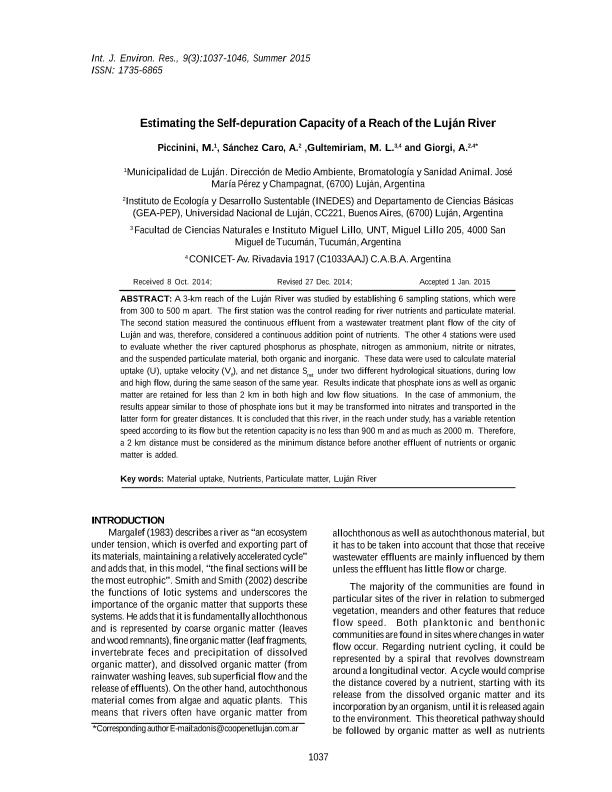Mostrar el registro sencillo del ítem
dc.contributor.author
Piccinini, Mauricio
dc.contributor.author
Sánchez Caro, Anibal
dc.contributor.author
Gultermiriam, M.L.
dc.contributor.author
Giorgi, Adonis David Nazareno

dc.date.available
2020-01-30T18:09:30Z
dc.date.issued
2015-08
dc.identifier.citation
Piccinini, Mauricio; Sánchez Caro, Anibal; Gultermiriam, M.L.; Giorgi, Adonis David Nazareno; Estimating the Self-depuration Capacity of a Reach of the Luján River; University of Tehran; International Journal Of Environmental Research; 9; 3; 8-2015; 1037-1046
dc.identifier.issn
1735-6865
dc.identifier.uri
http://hdl.handle.net/11336/96237
dc.description.abstract
A 3-km reach of the Luján River was studied by establishing 6 sampling stations, which were from 300 to 500 m apart. The first station was the control reading for river nutrients and particulate material. The second station measured the continuous effluent from a wastewater treatment plant flow of the city of Luján and was, therefore, considered a continuous addition point of nutrients. The other 4 stations were used to evaluate whether the river captured phosphorus as phosphate, nitrogen as ammonium, nitrite or nitrates, and the suspended particulate material, both organic and inorganic. These data were used to calculate material uptake (U), uptake velocity (Vf), and net distance Snet under two different hydrological situations, during low and high flow, during the same season of the same year. Results indicate that phosphate ions as well as organic matter are retained for less than 2 km in both high and low flow situations. In the case of ammonium, the results appear similar to those of phosphate ions but it may be transformed into nitrates and transported in the latter form for greater distances. It is concluded that this river, in the reach under study, has a variable retention speed according to its flow but the retention capacity is no less than 900 m and as much as 2000 m. Therefore, a 2 km distance must be considered as the minimum distance before another effluent of nutrients or organic matter is added.
dc.format
application/pdf
dc.language.iso
eng
dc.publisher
University of Tehran

dc.rights
info:eu-repo/semantics/openAccess
dc.rights.uri
https://creativecommons.org/licenses/by-nc-sa/2.5/ar/
dc.subject
material uptake
dc.subject
nutrients
dc.subject
particulate matter
dc.subject
Lujan river
dc.subject.classification
Otras Ciencias de la Tierra y relacionadas con el Medio Ambiente

dc.subject.classification
Ciencias de la Tierra y relacionadas con el Medio Ambiente

dc.subject.classification
CIENCIAS NATURALES Y EXACTAS

dc.title
Estimating the Self-depuration Capacity of a Reach of the Luján River
dc.type
info:eu-repo/semantics/article
dc.type
info:ar-repo/semantics/artículo
dc.type
info:eu-repo/semantics/publishedVersion
dc.date.updated
2019-12-27T14:04:11Z
dc.journal.volume
9
dc.journal.number
3
dc.journal.pagination
1037-1046
dc.journal.pais
Irán

dc.journal.ciudad
Tehran
dc.description.fil
Fil: Piccinini, Mauricio. Provincia de Buenos Aires. Municipalidad de Lujan; Argentina
dc.description.fil
Fil: Sánchez Caro, Anibal. Universidad Nacional de Luján. Instituto de Ecología y Desarrollo Sustentable. Consejo Nacional de Investigaciones Científicas y Técnicas. Oficina de Coordinación Administrativa Parque Centenario. Instituto de Ecología y Desarrollo Sustentable; Argentina. Universidad Nacional de Luján. Departamento de Ciencias Básicas; Argentina
dc.description.fil
Fil: Gultermiriam, M.L.. Universidad Nacional de Tucumán. Facultad de Ciencias Naturales e Instituto Miguel Lillo; Argentina. Consejo Nacional de Investigaciones Científicas y Técnicas; Argentina
dc.description.fil
Fil: Giorgi, Adonis David Nazareno. Universidad Nacional de Luján. Instituto de Ecología y Desarrollo Sustentable. Consejo Nacional de Investigaciones Científicas y Técnicas. Oficina de Coordinación Administrativa Parque Centenario. Instituto de Ecología y Desarrollo Sustentable; Argentina. Universidad Nacional de Luján. Departamento de Ciencias Básicas; Argentina. Consejo Nacional de Investigaciones Científicas y Técnicas; Argentina
dc.journal.title
International Journal Of Environmental Research

dc.relation.alternativeid
info:eu-repo/semantics/altIdentifier/url/https://ijer.ut.ac.ir/article_991.html
dc.relation.alternativeid
info:eu-repo/semantics/altIdentifier/doi/http://dx.doi.org/10.22059/IJER.2015.991
Archivos asociados
